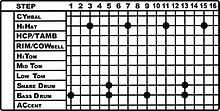Drum machine
- For the early "drum machine" computers that used a rotating cylinder as their main memory, see drum memory
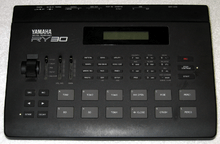
A drum machine is an electronic musical instrument designed to imitate the sound of drums or other percussion instruments. Drum machines are most commonly associated with electronic music, but are also used in many other genres. They are also a common necessity when session drummers are not available or desired.
Most modern drum machines are sequencers with a sample playback (rompler) or synthesizer component that specializes in the reproduction of drum timbres. Though features vary from model to model, many modern drum machines can also produce unique sounds, and allow the user to compose unique drum beats.
History
Early drum machines
- Rhythmicon (1930–1932)
In 1930–32, the spectacularly innovative and hard to use Rhythmicon was realized by Leon Theremin at the request of Henry Cowell, who wanted an instrument which could play compositions with multiple rhythmic patterns, based on the overtone series, were far too hard to perform on existing keyboard instruments. The invention could produce sixteen different rhythms, each associated with a particular pitch, either individually or in any combination, including en masse, if desired. Received with considerable interest when it was publicly introduced in 1932, the Rhythmicon was soon set aside by Cowell and was virtually forgotten for decades. The next generation of rhythm machines played only pre-programmed rhythms such as mambo, tango, or bossa nova.
- Chamberlin Rhythmate (1957)
In 1957 Californian Harry Chamberlin constructed a tape loop based drum machine called the Chamberlin Rhythmate. It had 14 tape loops with a sliding head that allowed playback of different tracks on each piece of tape, or a blending between them. It contained a volume and a pitch/speed control and also had a separate amplifier with bass, treble, and volume controls, and an input jack for a guitar, microphone or other instrument. The tape loops were of real acoustic jazz drum kits playing different style beats, with some additions to tracks such as bongos, clave, castanets, etc.
- Raymond Scott's machines (1960/1963)
In 1960 Raymond Scott constructed the Rhythm Synthesizer and, in 1963, a drum machine called Bandito the Bongo Artist. Scott's machines were used for recording his album"Soothing Sounds for Baby" series (1964).
- First commercial product – Wurlitzer Sideman (1959)
.jpg)
In 1959 Wurlitzer released an electro-mechanical drum machine called the Sideman, which was the first ever commercially-produced drum machine. The Sideman was intended as a percussive accompaniment for the Wurlitzer organ range. The Sideman offered a choice of 12 electronically generated, predefined rhythm patterns with variable tempos. The sound source was a series of vacuum tubes which created 10 preset electronic drum sounds. The drum sounds were 'sequenced' by a rotating wiper arm with contact brushes on it that swept around a phenolic panel with corresponding contacts arranged in a pattern of concentric circles across its face; these were spaced in certain patterns to generate parts of a particular rhythm. Combinations of these different sets of rhythms and drum sounds created popular rhythmic patterns of the day, e.g. waltzes, fox trots etc. These combinations were selected by a rotary knob on the top of the Sideman box. The tempo of the patterns was controlled by a slider that increased the speed of rotation of the wiper arm. The Sideman had a panel of 10 buttons for manually triggering drum sounds, and a remote player to control the machine while playing from an organ keyboard. The Sideman was housed in a mahogany cabinet that contained the sound generating circuitry, amplifier and speaker.[1]
- First fully transistorized drum machines – Seeburg/Gulbransen (1964)
.jpg)
using mechanical wheel, as seen on bailed out left panel
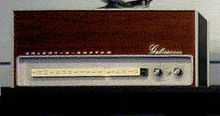
an earliest fully transistorized rhythm machine
During the 1960s, implementation of rhythm machines were evolved into fully solid-state (transistorized) from early electro-mechanical with vacuum tubes, and also size were reduced to desktop size from earlier floor type. In the early 1960s, a home organ manufacturer, Gulbransen (later acquired by Fender) cooperated with an automatic musical equipment manufacturer Seeburg Corporation, and released early compact rhythm machines Rhythm Prince (PRP),[2] although, at that time, these size were still as large as small guitar amp head, due to the use of bulky electro-mechanical pattern generators. Then in 1964, Seeburg invented a compact electronic rhythm pattern generator using "diode matrix" (U.S. Patent 3,358,068 in 1967),[3] and fully transistorized electronic rhythm machine with pre-programmed patterns, Select-A-Rhythm (SAR1),[4][5] was released. As the result of its robustness and enough compact size, these rhythm machines (and also similar products by followers[6]) were gradually installed on the electronic organ as accompaniment of organists, and finally spread widely.
- Ace Tone (c.1967)
Circa 1967, also the Ace Tone developed the preset rhythm-pattern generator using diode matrix circuit[6] similar to the prior patent by Seeburg,[3] and commercialized their first preset rhythm machine called "FR-1 Rhythm Ace" in 1967. It offered 16 preset patterns, and four buttons to manually play each instrument sound (cymbal, claves, cowbell and bass drum). Also the rhythm patterns could be cascaded together by pushing multiple rhythm buttons simultaneously, and the possible combination of rhythm patterns were more than a hundred. (On the later models of Rhythm Ace, also the individual volumes of each instrument could be adjusted with the small knobs or faders) The FR-1 was adopted by the Hammond Organ Company for incorporation within their latest organ models. In the US, the units were also marketed under the Multivox brand by Peter Sorkin Music Company, and in the UK, marketed under the Bentley Rhythm Ace brand. The Bentley-branded Rhythm Ace inspired the 1997 Birmingham band Bentley Rhythm Ace when a model was found at a car boot sale. The unique artificial sounds characteristics of the FR-1 were similar to the later Roland rhythm machines, and featured on the electronic pop music from the late 1970s onwards.[7]
- Early preset drum machine's users
A number of other preset drum machines were released in the 1970s, but early examples of the use can be found on The United States of America's eponymous album from 1967–8. The first major pop song to use a drum machine was "Saved by the Bell" by Robin Gibb, which reached #2 in Britain in 1969. Drum machine tracks were also heavily used on the Sly & the Family Stone album There's a Riot Goin' On, released in 1971. The German krautrock band Can also used a drum machine on their song "Peking O". The 1972 Timmy Thomas single "Why Can't We Live Together"/"Funky Me" featured a distinctive use of a drum machine and keyboard arrangement on both tracks. Another early example of electronic drums used by a rock group, is Obscured by Clouds by Pink Floyd, from early in 1972. The first album on which a drum machine produced all the percussion was Kingdom Come's Journey, recorded in November 1972 using a Bentley Rhythm Ace. French singer-songwriter Léo Ferré mixed a drum machine with a symphonic orchestra in the song "Je t'aimais bien, tu sais..." in his album L'Espoir, released in 1974. Osamu Kitajima's progressive psychedelic rock album Benzaiten (1974) also utilized drum machines, and one of the album's contributors, Haruomi Hosono,[8] would later start the electronic music band Yellow Magic Orchestra (as "Yellow Magic Band") in 1977.[9]
Drum sound synthesis
A key difference between such early machines and more modern equipment is that they use sound synthesis rather than digital sampling in order to generate their sounds. For example, a snare drum or maraca sound would typically be created using a burst of white noise whereas a bass drum sound would be made using sine waves or other basic waveforms. This meant that while the resulting sound was not very close to that of the real instrument, each model tended to have a unique character. For this reason, many of these early machines have achieved a certain "cult status" and are now sought after by producers for use in production of modern electronic music, most notably the Roland TR-808.[10]
Programmable drum machines

One of the first programmable drum machines
In 1972, Eko released the ComputeRhythm (1972), which was the first programmable drum machine. It had a 6-row push-button matrix that allowed the user to enter a pattern manually. The user could also push punch cards with pre-programmed rhythms through a reader slot on the unit.[11] In 1975, Ace Tone released its successor to the Rhythm Ace series, the Rhythm Producer FR-15, which provided the feature to modify the pre-programmed rhythms.[12] Another stand-alone drum machine, the PAiA Programmable Drum Set released in 1975, was also one of the first programmable drum machines,[13] and was sold as a kit with parts and instructions which the buyer would use to build the machine.
In 1978, the Roland CR-78 drum machine was released. It was a programmable rhythm machine, and had four memory locations which allowed users to store their own patterns. The following year, Roland offered a simpler version, the Boss DR-55. It had only four sounds.
Digital sampling
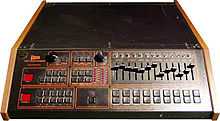
The Linn LM-1 Drum Computer (released in 1980 at $4,995) was the first drum machine to use digital samples. Only about 500 were ever made, but its effect on the music industry was extensive. Its distinctive sound almost defines 1980s pop, and it can be heard on hundreds of hit records from the era, including The Human League's Dare, Gary Numan's Dance, Devo's "New Traditionalists", and Ric Ocasek's Beatitude. Prince bought one of the very first LM-1s and used it on nearly all of his most popular recordings, including 1999 and Purple Rain.
Many of the drum sounds on the LM-1 were composed of two chips that were triggered at the same time, and each voice was individually tunable with individual outputs. Due to memory limitations, a crash cymbal sound was not available except as an expensive third-party modification. A cheaper version of the LM-1 was released in 1982 called the LinnDrum. Priced at $2,995, not all of its voices were tunable, but crash cymbal was included as a standard sound. Like its predecessor the LM-1, it featured swappable sound chips. The LinnDrum can be heard on records such as The Cars' Heartbeat City and Giorgio Moroder's soundtrack for the film Scarface.
It was feared the LM-1 would put every session drummer in Los Angeles out of work and it caused many of L.A's top session drummers (Jeff Porcaro is one example) to purchase their own drum machines and learn to program them themselves in order to stay employed. Linn even marketed the LinnDrum specifically to drummers.[14]
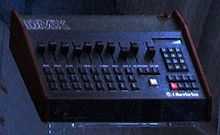

Following the success of the LM-1, Oberheim introduced the DMX, which also featured digitally-sampled sounds and a "swing" feature similar to the one found on the Linn machines. It became very popular in its own right, becoming a staple of the nascent hip-hop scene.
Other manufacturers soon began to produce machines, e.g. the Sequential Circuits Drum-Traks and Tom, the E-mu Drumulator and the Yamaha RX11.
In the 1986, SpecDrum by Cheetah Marketing, an inexpensive 8-bit sampling drum external module for ZX Spectrum,[15] was introduced. And its price was less than £30 when similar models cost around £250.[16]
Roland TR-808 and TR-909 machines
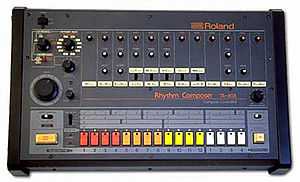
The famous Roland TR-808, a programmable drum machine, was also launched in 1980. At the time it was received with little fanfare, as it did not have digitally sampled sounds; drum machines using digital samples were much more popular. In time, though, the TR-808, along with its successor, the TR-909 (released in 1983), would become a fixture of the burgeoning underground dance, electro, house, techno, R&B and hip-hop genres, mainly because of its low cost (relative to that of the Linn machines) and the unique character of its analogue-generated sounds, which included five unique percussion sounds: “the hum kick, the ticky snare, the tishy hi-hats (open and closed) and the spacey cowbell.” It was first utilized by Yellow Magic Orchestra in the year of its release, after which it would gain further popularity with Marvin Gaye's "Sexual Healing" and Afrikaa Bambaataa's "Planet Rock" in 1982.[10]
In a somewhat ironic twist it is the analogue-based Roland machines that have endured over time as the Linn sound became somewhat overused and dated by the end of the decade. The TR-808 and TR-909's beats have since been widely featured in pop music, and can be heard on countless recordings up to the present day.[10] Because of its bass and long decay, the kick drum from the TR-808 has also featured as a bass line in various genres such as hip hop and drum and bass. Since the mid-1980s, the TR-808 and TR-909 have been used on more hit records than any other drum machine,[17] and has thus attained an iconic status within the music industry.[10]
MIDI breakthrough
Because these early drum machines came out before the introduction of MIDI in 1983, they use a variety of methods of having their rhythms synchronized to other electronic devices. Some used a method of synchronization called DIN-sync, or Sync-24. Some of these machines also output analog CV/Gate voltages that could be used to synchronize or control analog synthesizers and other music equipment. The Oberheim DMX came with a feature allowing it to be synchronized to its proprietary Oberheim Parallel Buss interfacing system, developed prior to the introduction of MIDI.
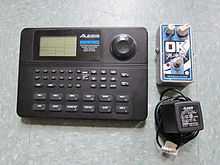
By the year 2000, standalone drum machines became much less common, being partly supplanted by general-purpose hardware samplers controlled by sequencers (built-in or external), software-based sequencing and sampling and the use of loops, and music workstations with integrated sequencing and drum sounds. TR-808 and other digitized drum machine sounds can be found in archives on the Internet. However, traditional drum machines are still being made by companies such as Roland Corporation (under the name Boss), Zoom, Korg and Alesis, whose SR-16 drum machine has remained popular since it was introduced in 1991.
There are percussion-specific sound modules that can be triggered by pickups, trigger pads, or through MIDI. These are called drum modules; the Alesis D4 and Roland TD-8 are popular examples. Unless such a sound module also features a sequencer, it is, strictly speaking, not a drum machine.
Programming
Programming of drum machines are varied by the products. On most products, it can be done in real time: the user creates drum patterns by pressing the trigger pads as though a drum kit were being played; or using step-sequencing: the pattern is built up over time by adding individual sounds at certain points by placing them, as with the TR-808 and TR-909, along a 16-step bar. For example, a generic 4-on-the-floor dance pattern could be made by placing a closed high hat on the 3rd, 7th, 11th, and 15th steps, then a kick drum on the 1st, 5th, 9th, and 13th steps, and a clap or snare on the 5th and 13th. This pattern could be varied in a multitude of ways to obtain fills, break-downs and other elements that the programmer sees fit, which in turn could be sequenced with song-sequence — essentially the drum machine plays back the programmed patterns from memory in an order the programmer has chosen. The machine will quantize entries that are slightly off-beat in order to make them exactly in time.
If the drum machine has MIDI connectivity, then one could program the drum machine with a computer or another MIDI device.
Drum Machines and Labor
Drum machines developed out of a utilitarian need, to create drum beats when a drum kit was not available. Increasingly, drum machines and drum programming are used by major record labels to undercut the costly expense of studio drummers.[18]
See also
References
- ↑ US patent 3207835, Howard E. Holman and Joseph H. Hearne (Wurlitzer Company), "Rhythm Device", issued 1965-09-21
- ↑ "Vintage Seeburg Rhythm Prince Drum Machine". MatrixSynth. February 02, 211. Check date values in:
|date=(help) - ↑ 3.0 3.1 US patent 3358068, Richard H. Campbell, Jr., Gilford, N.H. (Seeburg Corporation), "Musical Instruments", issued 1967-12-12
— When this patent was filed in 1964-06-26, also Automatic Rhythm Device, Automatic Repetitive Rhythm Instrument Timing Circuitry, and its sound circuits Snare Drum Instrument and Cow Bell Instrument were filed at the same time. - ↑ Seeburg Portable Select-A-Rhythm Service Manual (PDF). Seeburg Sales Corporation. Archived from the original (PDF) on 2012-04-25. — rhythm patterns were fully electronically generated by 48-step binary counter using 6-stage flip-flops
- ↑ "Seeburg Select-a-Rhythm Vintage Drum Machine". MatrixSynth. May 3, 2011.
- ↑ 6.0 6.1 US patent 3651241, Ikutaro Kakehashi (Ace Electronics Industries, Inc.), "Automatic Rhythm Performance Device", issued 1972-03-21 — an example of follower's similar patent in 1972
- ↑ Reid, Gordon (2004), "The History Of Roland Part 1: 1930–1978", Sound on Sound (November), retrieved 19 June 2011
- ↑ Osamu Kitajima – Benzaiten at Discogs
- ↑ Harry Hosono And The Yellow Magic Band – Paraiso at Discogs
- ↑ 10.0 10.1 10.2 10.3 Jason Anderson (November 28, 2008). "Slaves to the rhythm: Kanye West is the latest to pay tribute to a classic drum machine". CBC News. Retrieved 2011-05-29.
- ↑ "The EKO ComputeRhythm – Jean Michel Jarre’s Drum Machine". synthtopia.com.
- ↑ "Ace Tone Rhythm Producer FR-15". ESTECHO.com. — Sakata Shokai/Ace Tone Rhythm Producer, a successor of Rhythm Ace after the reconstruction of Ace Tone brand in 1972, provided feature to modify the pre-programmed rhythms.
- ↑ "Programmable Drum Set". Synthmuseum.com. Retrieved 2007-06-16.
- ↑ "Why Drummers Prefer LinnDrum to Other Drum Machines". Modern Drummer Magazine. 1984.
- ↑ Ryan Block (2005-10-28). "Music Thing: The ZX Spectrum SpecDrum module". engadget.com.
- ↑ P Henning; A Pateman. "Specdrum". Crash Magazine.
- ↑ Peter Wells (2004), A Beginner's Guide to Digital Video, AVA Books, p. 18, ISBN 2-88479-037-3, retrieved 2011-05-20
- ↑ D Arditi. "Digital Downsizing: The Effects of Digital Music Production on Labor". Journal of Popular Music Studies.
External links
- First appearance of Linn LM-1 Drum Computer-first advertisements
- WikiRecording's How to Make Real Drums Sound like an 80s Drum Machine
- http://drum-machines-history.blogspot.co.uk/

